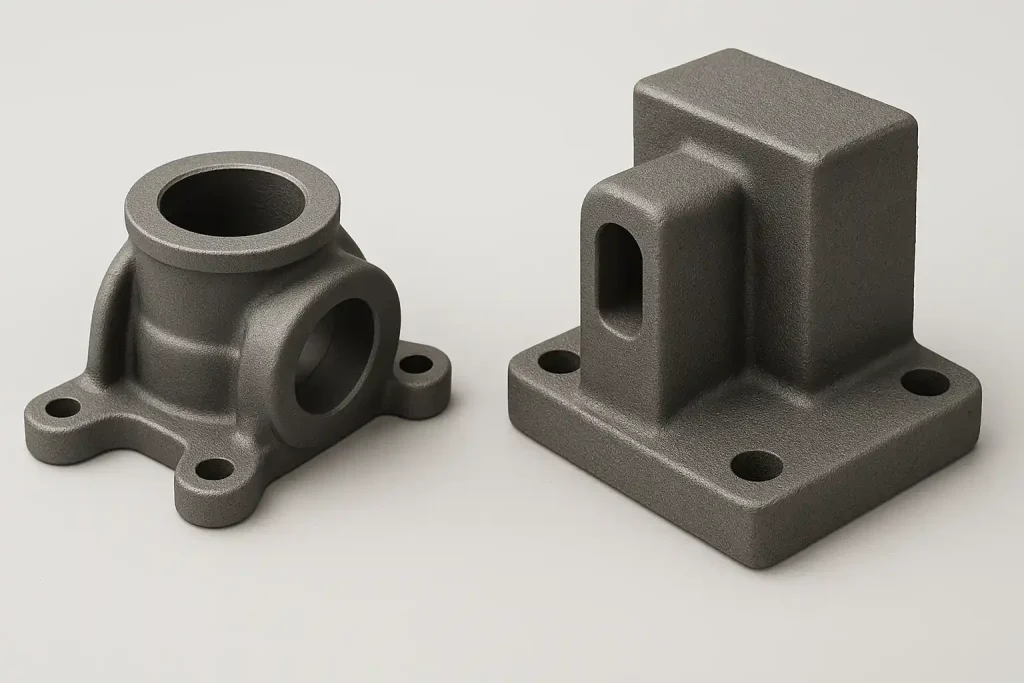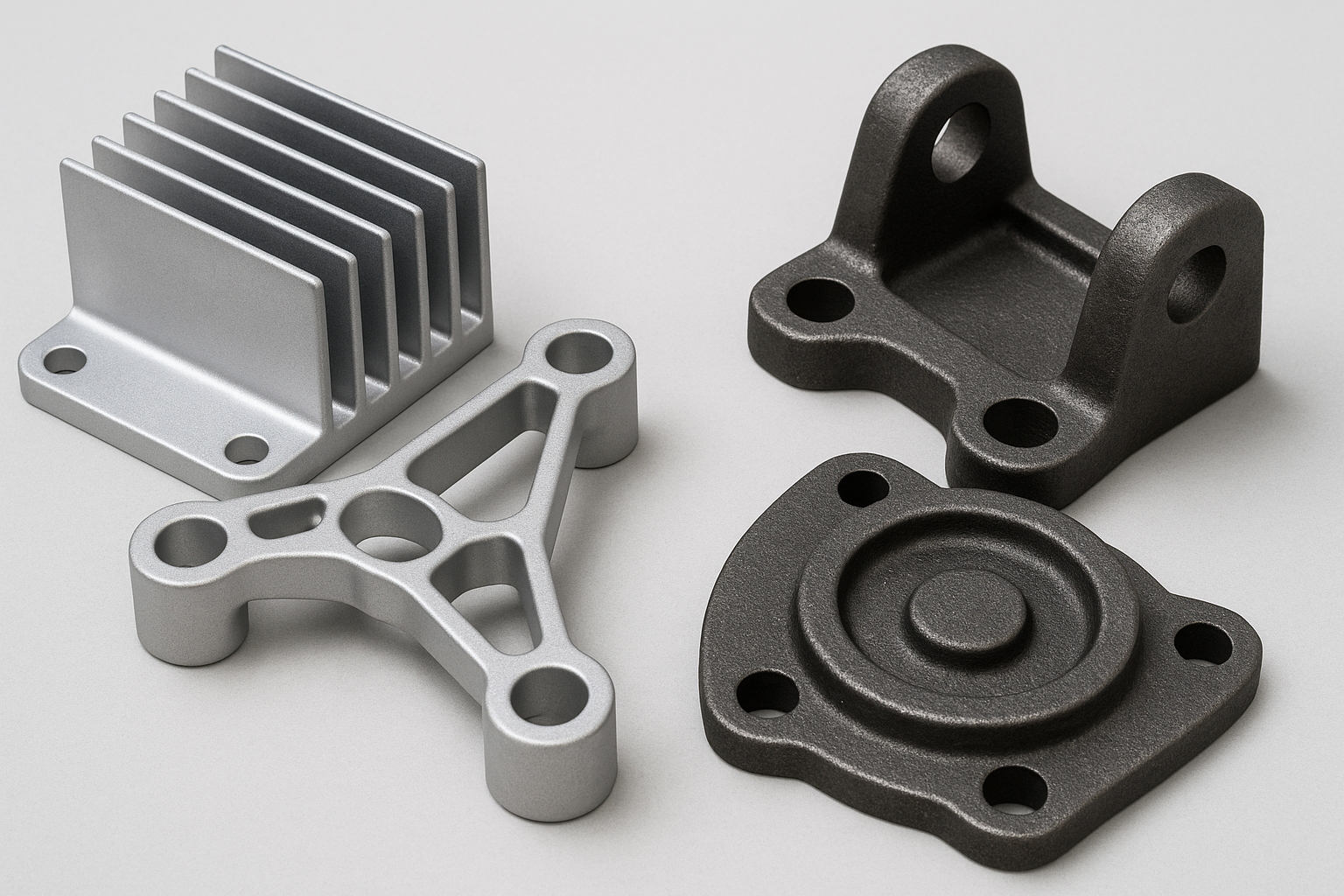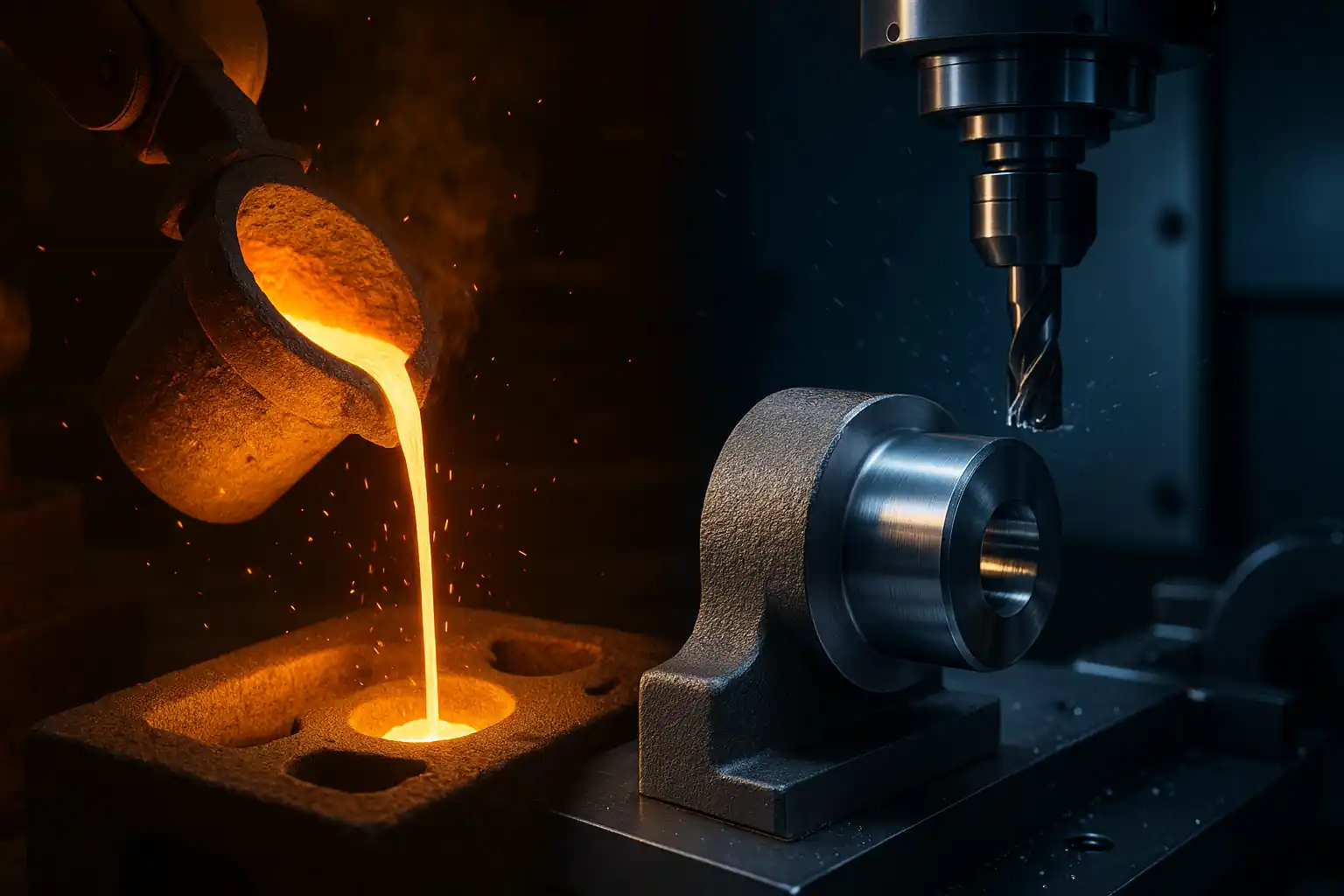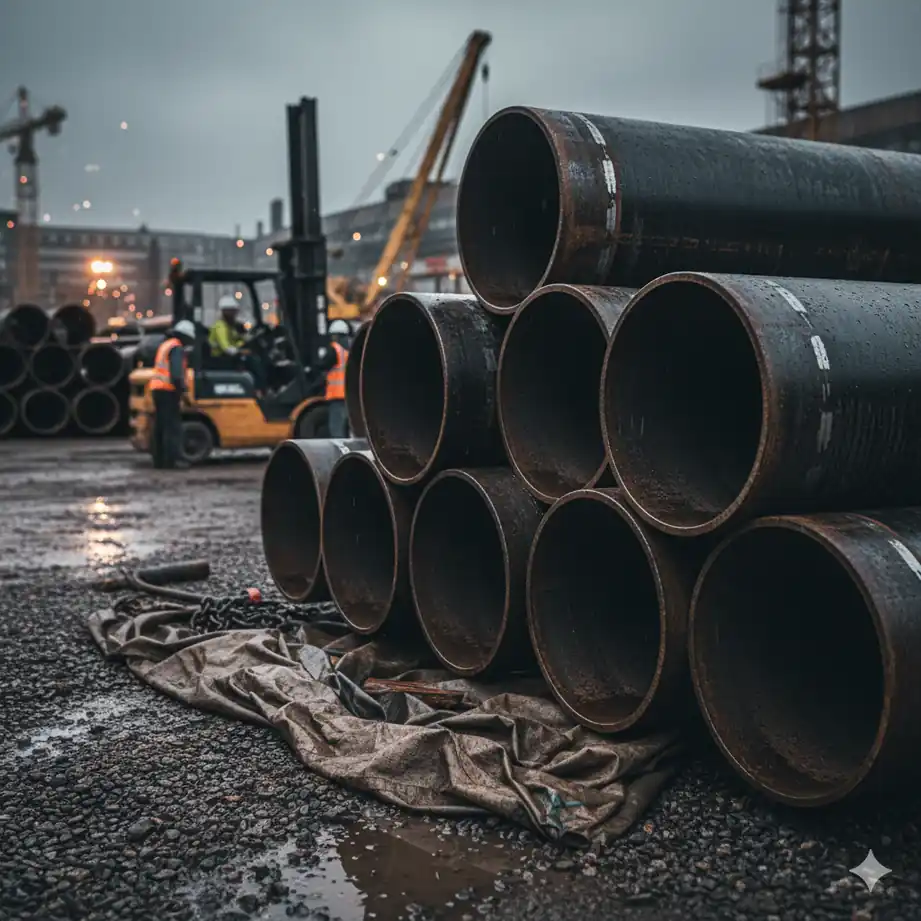ねずみ鋳鉄とダクタイル鋳鉄:主な違いと選び方
鋳鉄部品を調達する際、エンジニアやバイヤーがよくする最初の質問がある:
ねずみ鋳鉄にすべきか、ダクタイル鋳鉄にすべきか?
一見すると、その答えは予算や必要な強度によって決まるように思えるかもしれません。しかし実際には、部品がどのように機能するか、つまり負荷の種類、振動環境、要求される表面仕上げなどによって、正しい選択が形作られるのです。
この記事では、ねずみ鋳鉄とダクタイル鋳鉄の構造、性能、コストの違いについて、実用的な内訳を説明します。工学的な見識と実際の用途に裏打ちされたこの記事は、プロジェクトに最も信頼できる材料を選択するのに役立ちます。
グラファイトの構造:性能差の根源
ねずみ鋳鉄もダクタイル鋳鉄も黒鉛鋳鉄だが、その黒鉛の形状がすべてを決定する。
- グレー・アイアン はフレーク状のグラファイトを含んでおり、これが金属マトリックスを破壊し、引張強度の低下につながる。この薄片は小さな亀裂のような働きをし、強度には不利だが、加工中の振動を吸収したり、切り屑を砕いたりするのには優れている。
- ダクタイル鋳鉄 はグラファイトを球状ノジュールに変化させる。この丸い介在物はマトリックスの連続性を維持し、はるかに高い引張強さ、優れた伸び、耐衝撃性を可能にする。この構造上の利点により、ダクタイル鋳鉄は高い機械的応力や動的荷重がかかる部品に適している。
わかりやすく言えば、"ヴェニュー "である:
フレークがストレスを壊す→ノジュールがストレスを運ぶ。
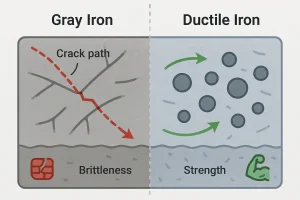
ねずみ鋳鉄に含まれる黒鉛はフレークを形成し、ダクタイル鋳鉄はノジュールを形成する。
機械的性能:強度、伸び、耐衝撃性
鋳鉄部品の機械的特性は、荷重下での挙動を定義します。ここでは、ねずみ鋳鉄とダクタイル鋳鉄が最も重要な部分でどのように異なるかを説明します:
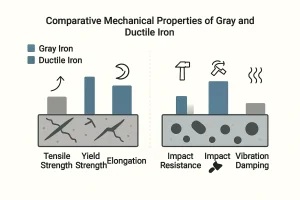
ねずみ鋳鉄とダクタイル鋳鉄の引張強さ、降伏強さ、伸びを比較した棒グラフ。
| プロパティ | グレー・アイアン | ダクタイル鋳鉄 |
|---|---|---|
| グラファイト・フォーム | フレーク状グラファイト | 球状黒鉛 |
| 引張強度 | 150-400 MPa | 400-700 MPa |
| 降伏強度 | 定義なし(脆い) | 250-500 MPa |
| 破断伸度 | < 1% | 10-18% |
| 耐衝撃性 | 非常に低い(ノッチに敏感) | 高い(低温でも) |
- 灰色の鉄 圧縮時には強いが、引張時や衝撃時には割れやすい。
- ダクタイル鋳鉄 延性に富み、弾力性に富み、警告なしに故障する可能性がはるかに低い。
部品が動的荷重や不規則な荷重に直面する可能性がある場合、ダクタイル鋳鉄はより安全なエンジニアリングの選択です。
振動減衰と音響挙動
ねずみ鋳鉄が得意とする分野のひとつに振動減衰がある。フレーク状のグラファイト構造が音波や振動波を遮断し、内部でエネルギーを発散させます。このため、ねずみ鋳鉄は理想的な素材となる:
- 工作機械ベース
- 電動モーターハウジング
- ポンプおよびコンプレッサー・ブロック
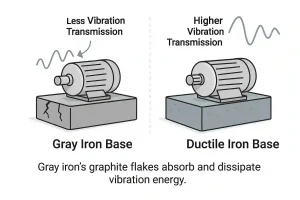
ねずみ鋳鉄は、フレーク状黒鉛のため振動を吸収しやすく、モーター・ハウジングやマシン・ベースに最適です。
このような場合、性能とは強度ではなく、安定性のことです。ビビリや振動、共振を起こす部品は、寸法精度やノイズ、疲労の原因となります。
ダクタイル鋳鉄は、強度が高い反面、減衰が少ない。ノジュラー・グラファイトは振動エネルギーをより直接的に伝えるため、高精度の用途では二次的な制振対策が必要になることがある。
鋳造性、機械加工性、鋳造に関する考察
製造の観点からは、ねずみ鋳鉄の方がより寛容な材料である。流動性に優れているため、薄肉で複雑な金型に充填しても欠陥が少ない。また、冷却速度の変化にも影響を受けにくい。
ねずみ鋳鉄の加工も簡単だ:
- フレーク状グラファイトは、内蔵のチップブレーカーと潤滑剤として機能する。
- 特に高速加工では、工具寿命が長くなる。
- 表面仕上げは一般的に優れている。
ダクタイル鋳鉄は、鋳造性は良いが、より堅牢なゲーテ ィングと押湯設計が必要になる場合がある。高い硬度と結節構造により、工具摩耗と切削抵抗が増加しますが、適切な工具と送りを使用すれば、これらの影響を最小限に抑えることができます。
大規模な機械加工が必要な部品や複雑な形状の部品の場合、ねずみ鋳鉄の方が製造コストを低く抑えられる可能性があります。
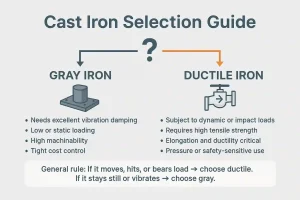
用途に応じてねずみ鋳鉄またはダクタイル鋳鉄を選択するためのクイック・リファレンス・ガイド。
コスト
鋳造プロジェクトでは、コストとは材料価格だけのことではありません。
灰色の鉄 は明らかにコスト面で有利である:
- 原材料コストの低減
- 結節化添加剤(マグネシウムなど)が不要
- 鋳造時の工程管理が少なくて済む
- より速く、より経済的な加工
ダクタイル鋳鉄 は追加のステップを導入する:
- 球状黒鉛形成に対する処置
- 制御すべきプロセス変数の増加(温度、接種タイミング)
- 硬度が高いほど加工時間が長くなり、工具の摩耗が増加する
予算が厳しい大量生産部品の場合、ねずみ鋳鉄は、複雑さにもよるが、15~25%のコスト削減が可能である。しかし、疲労や衝撃によってねずみ鋳鉄部品が故障した場合、当初の節約効果はすぐに消えてしまいます。
実例ドイツのオフロード車のギアハウジング
欧州の顧客であるドイツのオフロード機械メーカーは当初、ギヤハウジング部品にねずみ鋳鉄を選択していました。しかし、トルク振動や急激な負荷衝撃に繰り返しさらされた結果、早期に亀裂が発生しました。
に変更した。 EN-GJS-500-7 ダクタイル鋳鉄その結果、この部品の寿命は次のように延びた。 40%のみである。 12% が上昇した。この改善により、保証クレームが大幅に減少し、運転信頼性が向上し、最終的に総所有コストが削減された。
重要な用途では、ダクタイル鋳鉄の高い材料費は、性能の寿命と安全マージンによって相殺されることが多い。
用途別セレクションガイド
ねずみ鋳鉄とダクタイル鋳鉄のどちらを選ぶかを決める最善の方法は、材料の好みではなく、機能から始めることです。
| アプリケーション・タイプ | 推奨素材 | 理由 |
|---|---|---|
| マシンフレーム、モーターハウジング | グレー・アイアン | 高減衰、静荷重 |
| ポンプボディ、ブレーキローター | グレー・アイアン | 鋳造性、耐摩耗性 |
| 油圧バルブ、ギアハウジング | ダクタイル鋳鉄 | 圧力、衝撃荷重 |
| サスペンションアーム、パイプ継手 | ダクタイル鋳鉄 | 高ストレス、セーフティクリティカルな使用 |
| 大きな断面や不均一な形状 | ダクタイル鋳鉄 | 構造的な結束力の向上 |
まだわからない?これが一般的なルールだ:
- 動く、ぶつかる、負荷がかかる→延性を選ぶ。
- 動かない、振動する、加工が必要→グレーを選択。
鋳鉄製造における当社の能力
当社は、欧州の工業用顧客を中心に、国際規格に準拠したねずみ鋳鉄鋳物とダクタイル鋳鉄鋳物の両方を製造しています。
提供される素材:
- ねずみ鋳鉄:EN-GJL-150~EN-GJL-300
- ダクタイル鋳鉄:EN-GJS-400-15、EN-GJS-500-7、EN-GJS-600-3
サービス
- 鋳造シミュレーションとデザイン・レビュー
- 微細構造の検証と機械的試験
- CNC機械加工と表面仕上げ
- 文書化(EN10204 3.1、PPAP、寸法報告書)
プロトタイプから生産まで、輸出準備の整ったパッケージングでプロジェクトをサポートし、EUと英国のお客様をサポートします。10個でも10,000個でも、私たちのチームは一貫性と技術的な信頼をお届けします。
結論素材のフィット感はパフォーマンス保険
ねずみ鋳鉄とダクタイル鋳鉄のどちらにも独自の利点があります。重要なのは、材料特性を機能的要求と一致させることです。
- 振動、コスト効率、加工のしやすさを考えると、ねずみ鋳鉄が最適です。
- ダクタイル鋳鉄は、強度、延性、動的性能が不可欠である。
適切なグレードを選択することは、単に部品の性能に影響を与えるだけでなく、貴社の評判、タイムライン、予算を守ることにもつながります。
よくある質問
Q1: ブレーキ・ローターにはどのタイプの鋳鉄が適していますか?
耐摩耗性と振動減衰特性に優れているため、一般的にはねずみ鋳鉄が好まれる。
Q2: 耐圧部品にダクタイル鋳鉄は使用できますか?
そうです。ダクタイル鋳鉄の球状黒鉛構造は、油圧バルブやサスペンションアームのような加圧および動的荷重の用途に必要な強度と伸びを与えます。
Q3: ねずみ鋳鉄はダクタイル鋳鉄より加工しやすいですか?
はい、ねずみ鋳鉄に含まれる薄片状黒鉛は、天然のチップブレーカーと潤滑剤として機能し、機械加工をより簡単で経済的にします。
鋳鉄の選択で専門家の助けを得る
部品設計の評価や適切な材料の選択にお困りですか?
図面や技術的なご要望をお送りいただければ、ご指導、ご提案、競争力のあるお見積もりを提供いたします。
👉 お問い合わせ を始める。
